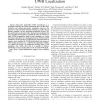Free Online Productivity Tools
i2Speak
i2Symbol
i2OCR
iTex2Img
iWeb2Print
iWeb2Shot
i2Type
iPdf2Split
iPdf2Merge
i2Bopomofo
i2Arabic
i2Style
i2Image
i2PDF
iLatex2Rtf
Sci2ools
GLOBECOM
2009
IEEE
2009
IEEE
Nonparametric Obstruction Detection for UWB Localization
Ultra-wide bandwidth (UWB) transmission is a promising technology for indoor localization due to its fine delay resolution and obstacle-penetration capabilities. However, the presence of walls and other obstacles introduces a positive bias in distance estimates, severely degrading localization accuracy. We have performed an extensive indoor measurement campaign with FCC-compliant UWB radios to quantify the effect of non-line-ofsight (NLOS) propagation. Based on this campaign, we extract key features that allow us to distinguish between NLOS and LOS conditions. We then propose a nonparametric approach based on support vector machines for NLOS identification, and compare it with existing parametric (i.e., model-based) approaches. Finally, we evaluate the impact on localization through Monte Carlo simulation. Our results show that it is possible to improve positioning accuracy relying solely on the received UWB signal.
| Added | 18 Feb 2011 |
| Updated | 18 Feb 2011 |
| Type | Journal |
| Year | 2009 |
| Where | GLOBECOM |
| Authors | Stefano Maranò, Wesley M. Gifford, Henk Wymeersch, Moe Z. Win |
Comments (0)

